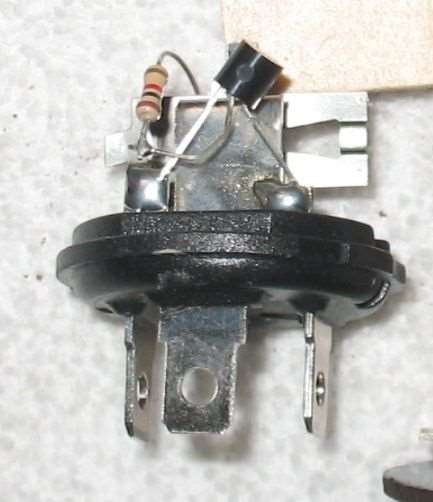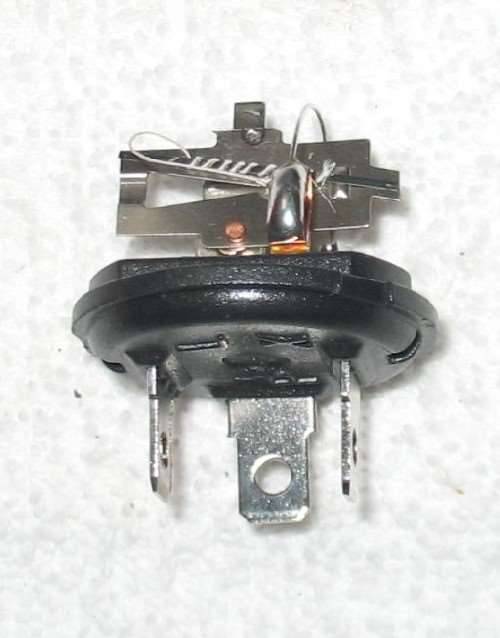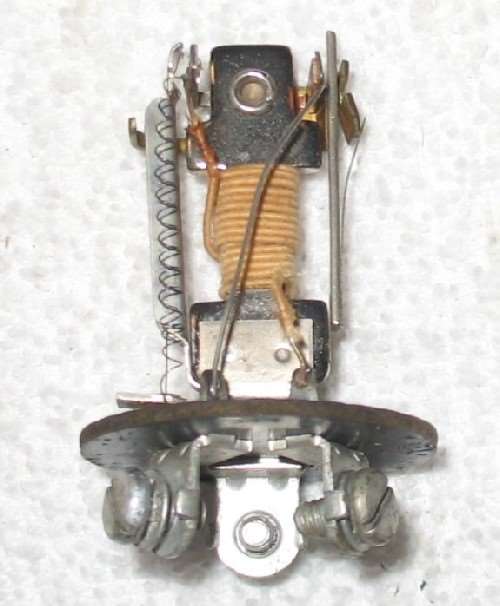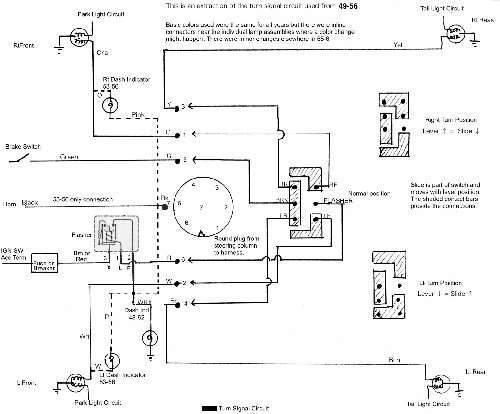|
Re: LED turn signals
|
||||
|---|---|---|---|---|
|
Forum Ambassador
|
On a 23rd, believe the flasher unit will be located in one of two places. In the cluster at the top left corner or in a socket which is part of the heavy stretch of wire loom behind the cluster.
Don't remember anyone on the forum as having tried an electronic flasher. 6v versions are kind of rare but there are a couple. The website offering the ones I know of doesn't say anything about polarity. I know some have said the 535 (which is supposed to be the 6v replacement for our old TungSol units) will work the outside bulbs but not the dash indicator light so they had to find an original type flasher. I took one of the 535s apart just to see how it was made and found there is a thermal unit working the outside bulbs but a transistor working the dash light. Transistors being polarity sensitive might explain why the dash light didn't work so would almost think the electronics are sensitive. One of the websites selling LED automotive bulbs mentions the need for a load resistor across the socket and LED to duplicate the old filament characteristics so the original flashers will work. That might be an option.
Posted on: 2015/1/10 16:25
|
|||
|
Howard
|
||||
|
||||
|
Re: LED turn signals
|
||||
|---|---|---|---|---|
|
Home away from home
|
Almost anything electrical is possible, but not always cost effective. I suggest you have to analyze how badly you want/need to do that and what's driving the need?
Is it the non-working or poor condition of the current lights or something else? Right now, I know of no, off the shelf, answer. You'd probably have to engineer it yourself, so it's a skills question too. I recently saw some LED replacement bulbs coming on but don't remember but don't think they fit these bases. The automotive market is competitive and year/model based so it's not easy to get engineering specs for modifications as it is in other markets. As Howard mentions, the LEDs have much less amp draw which saves energy by not producing heat. The old systems were designed/depended on higher amp draw. So it's the time/cost of repair vs the time/cost to upgrade. I'm sure myself and the forum readers would be happy to hear your methods and results. ps; I'm going non-stock and still looking at taillight options. I had a custom design then changed my mind after I had to integrate back-up lights and there weren't many complimentary options. Since my stock lenses are perfect, recessing and flushing them is one option under review but requires alot of hours to remake the whole base assy. I'm using small LED's for marker lights and elsewhere but will be 12V system.
Posted on: 2015/1/14 9:37
|
|||
|
||||
|
Re: LED turn signals
|
||||
|---|---|---|---|---|
|
Home away from home

|
Quote:
" I took one of the 535s apart just to see how it was made and found there is ..... a transistor working the dash light. Transistors being polarity sensitive might explain why the dash light didn't work ......." ok. But what about the possibility of removeing the xisistor, reverse it's position and resolder it into place????
Posted on: 2015/1/14 10:38
|
|||
|
VAPOR LOCK demystified: See paragraph SEVEN of PMCC documentaion as listed in post #11 of the following thread:f
packardinfo.com/xoops/html/modules/newbb/viewtopic.php?topic_id=7245 |
||||
|
||||
|
Re: LED turn signals
|
||||
|---|---|---|---|---|
|
Forum Ambassador
|
ok. But what about the possibility of removeing the xisistor, reverse it's position and resolder it into place????
It is not a 100% certainty that is the issue with the dash lights. Am assuming the cars were otherwise stock and just going on reports that to get the dash lights to work again they had to find an original flasher. I haven't personally verified the transistor is the reason but if so, not quite as simple as reversing. Typical transistors are classified as type PNP or NPN and are polarity specific. It would need a different transistor. Easy enough to do if you have the specs or the mfg number and can go to the catalog and find the complement to the one used. I didn't see a number on this one to cross or know what the specs are. It would take some research to get it right. Attach file:  (22.62 KB) (22.62 KB)
Posted on: 2015/1/14 11:09
|
|||
|
Howard
|
||||
|
||||
|
Re: LED turn signals
|
||||
|---|---|---|---|---|
|
Home away from home
|
My 54 Cavalier has the flasher in a socket which is tied into the wiring harnes behind the dash cluster.
The flasher works fine and makes the usual tink . . tink sound when the signal is flashing. The direction indicators in the dash cluster become a little dim when I sit at a light with the headlights and radio on as the voltage drops. The outside signal lights are normal bright. I thought after looking at the circuit diagram the dash indicators were in parallel with the signal lights. Maybe tine to recheck the schematic. If the transistor is connected with the polarity backwards, it is likely fried but not always. If you look closely at the flat face of the transistor there should be a part number which if you post it here we can look up. there transistors are usually a couple of bucks. So in looking at the picture the actual flasher is the bi-metal with the heat coil and the dash indicators run on a separate contact? Jim seperat contact? Jim
Posted on: 2015/1/14 13:27
|
|||
|
||||
|
Re: LED turn signals
|
||||
|---|---|---|---|---|
|
Forum Ambassador
|
So in looking at the picture the actual flasher is the bi-metal with the heat coil and the dash indicators run on a separate contact?
Here's a photo of the "working" side of the replacement flasher and one of the original TungSol as used on a 47. That one used a relay type arrangement with a heater and bimetal controlling the relay. Typical of most of the TungSols I've torn apart. The replacement is a heater and bimetal strip arrangement controlling the regular bulbs with the transistor substituting for the separate contact that switched the dash light in older flashers. Didn't find any identifying marks at all on the transistor --- just the black plastic case. Also throwing in an extraction I did some time back showing the turn signal circuit for most postwar Packards. 22nd series and earlier are different because the brake lights don't go thru the turn signal switch and indicator lights are wired differently. Color of tracers did change a tiny bit from year to year but overall the base wire colors are consistent. The dash bulbs changed from the single indicator used 49-52 to the duals from 53 on. I included both with the later ones in dashed lines.
Posted on: 2015/1/14 13:59
|
|||
|
Howard
|
||||
|
||||
|
Re: LED turn signals
|
||||
|---|---|---|---|---|
|
Webmaster
|
You can buy LED bulbs that are designed as straight replacements for the original style bulbs. Which means they have the resistors in them to keep the OEM flashers working. Just be aware that most LED bulbs are pretty Uni-directional and may look like a bright spot on your tail light housing as opposed to "filling" the housing with light.
Posted on: 2015/1/14 14:08
|
|||
|
-BigKev
1954 Packard Clipper Deluxe Touring Sedan -> Registry | Project Blog 1937 Packard 115-C Convertible Coupe -> Registry | Project Blog |
||||
|
||||
|
Re: LED turn signals
|
||||
|---|---|---|---|---|
|
Just popping in

|
I bought some LED bulbs at Hershey 2 and 3 years ago. I was planning to use them in my Studebaker and Crosley. I ran into the turn signal problem and did some research and found flashers that would work on lower draw bulbs. Of course a reason for all of us and particularly 6 volt vehicles is to decrease the current draw. It would be so nice to be able to leave parking lights on for an extended time and not have a dead pattery. On some of our cars that have not had new harnesess installed low draw lamps solve a problem of low capability generators.
Posted on: 2015/1/14 15:34
|
|||
|
||||
|
Re: LED turn signals
|
||||
|---|---|---|---|---|
|
Home away from home
|
FYI: just a suggestion. If you're having voltage drop off at idle, you might consider testing the voltage regulator(VR) and battery. You might be able to adjust the voltage regulator to a higher cut out voltage or may have to replace VR and/or battery or some wiring.
If a generators spinning it's capable of making current but the regulator tells it what to do with it. Things degrade with time. Contacts and wires oxidize etc, that changes the characteristics. Batteries lose ampacity and terminal and wire corrosion increases resistance dulling performance. Caution: If you set VR too high you'll cook the battery. Follow the recommended procedure.
Posted on: 2015/1/17 10:56
|
|||
|
||||










